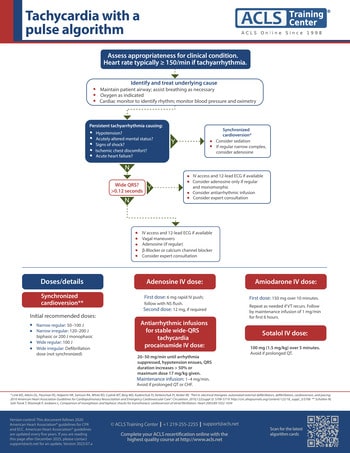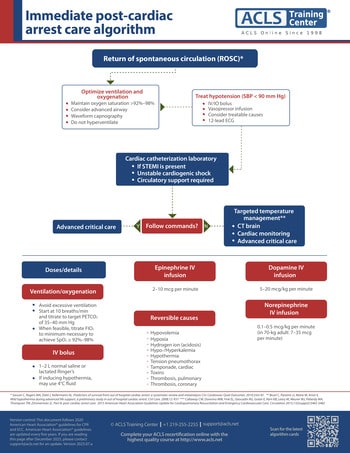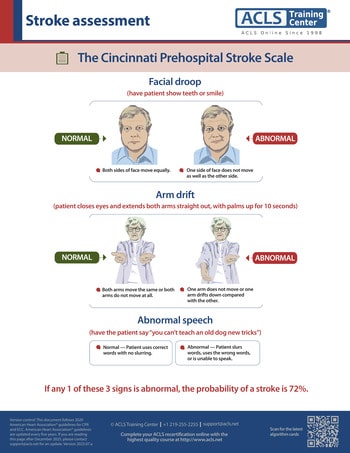ACLS algorithms for advanced cardiac life support
One of the crucial components of effective ACLS training is a familiarity with the major algorithms for different patient and/or provider scenarios. As a free resource for our visitors, this page contains links to sample algorithms for the main AHA advanced cardiac life support cases. See our website terms. Compatible part number: 90-1010.
See our separate pages for BLS algorithms and PALS algorithms.
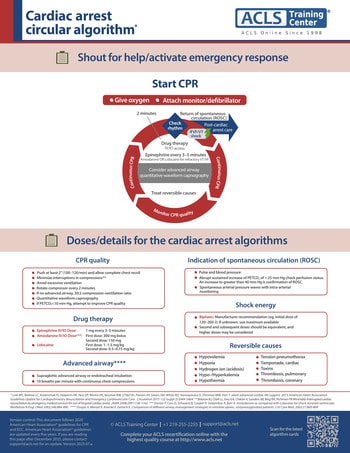
Cardiac arrest ACLS algorithm
This case presents the recommended assessment, intervention, and management options for a patient in respiratory arrest. The patient is unresponsive and unconscious. Respirations are absent or inadequate to maintain effective oxygenation and ventilation. The patient has a pulse. Even though the patient is in respiratory arrest and not in cardiac arrest, the BLS Primary Survey and the ACLS Secondary Survey are used.
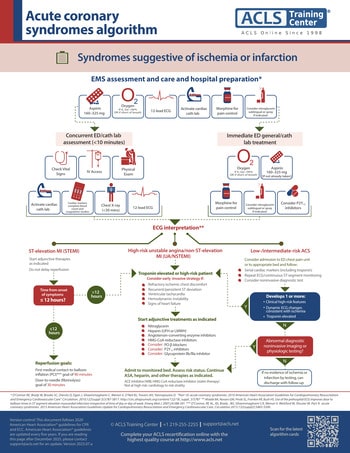
Acute coronary syndromes (ACS) algorithm
For this case, you use the acute coronary syndromes (ACS) algorithm to guide the assessment and management of patients with signs and symptoms of acute coronary syndromes. A key focus of the case is the identification and treatment of ST-segment elevation myocardial infarction (STEMI). You use a 12-lead ECG to evaluate the patient's rhythm. You initiate treatment based on your assessment.
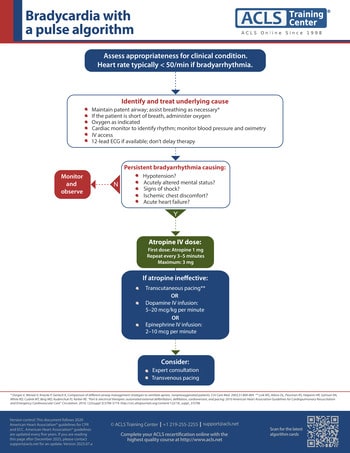
Bradycardia ACLS algorithm
This case outlines how to assess and manage a patient with symptomatic bradycardia. The patient has a pulse. One of your tasks is to figure out if the patient's signs and symptoms are caused by the slow heart rate or have an unrelated cause. Another task is to correctly diagnose the presence and type of atrioventricular (AV) block and implement the correct management strategies for AV blocks. You also need to know the techniques and cautions for using transcutaneous pacing.
Tachycardia ACLS algorithms
This case presents the assessment and management of a stable patient with a pulse who has a heart rate greater than 100 bpm. Your tasks are to classify the tachycardia as narrow or wide, regular or irregular, and to implement the appropriate interventions from the ACLS Tachycardia Algorithm, including vagal maneuvers and adenosine. Monitor the patient's rhythm and request a cardiac consultation if the patient's rhythm does not convert. If the patient becomes unstable, follow the algorithm for unstable tachycardia. For unstable tachycardia, you evaluate the patient for cardioversion and perform the procedure. Drugs are not used to manage unstable tachycardia.
Post-cardiac arrest care ACLS algorithm
This case presents how to respond to someone who collapses outside of the hospital setting from either ventricular fibrillation (VF) or ventricular tachycardia (VT). You are alone and must manage the patient by yourself. You do not have the option of ACLS interventions which you learned from ACLS online certification, including advanced airway control and IV medications. You have an automated external defibrillator (AED) with a pocket face mask. The second AED case focuses on the assessment and management of a patient in a witnessed cardiac arrest caused by ventricular fibrillation (VF) or pulseless ventricular tachycardia (VT). The patient did not respond to the first shock. A manual defibrillator is used in this case, and you work with a care team.
Suspected stroke ACLS algorithm
This case presents the identification (Cincinnati Prehospital Stroke Scale) and initial management of patients with acute ischemic stroke, a sudden change in neurological function brought on by a change in blood flow to the brain. This case is in scope for ACLS providers and covers fundamental out-of-hospital care, as well as basic aspects of initial in-hospital acute stroke care. This includes out-of-hospital and in-hospital situations, and National Institute of Neurological Disorders and Stroke (NINDS) time goals.
Other free study resources
Watch our ACLS instructional videos and prepare for renewal with our practice quizzes.
Planning to certify/recertify ACLS?
Get a reminder when you need to take the exam
ACLS anesthesia algorithms
These algorithms involve ACLS events in in-hospital settings for anesthetic and surgically related pathophysiology. Thank you to Vivek K. Moitra, MD, Andrea Gabrielli, MD, Gerald A. Maccioli, MD, and Michael F. O’Connor for providing this to us. Printed with permission.
Vivek K. Moitra, MD, Andrea Gabrielli, MD, Gerald A. Maccioli, MD, and Michael F. O’Connor, MD. Can J Anaesth. 2012 June; 59(6): 586-603.

Written by Jessica Munoz DPN, RN, CEN, providing nurse training at Yale New Haven Health-Bridgeport Hospital since 2022. Previously in healthcare and education at Griffin Hospital, St. Vincent's College of Nursing and Sacred Heart University Medical Center.
More by this author:
